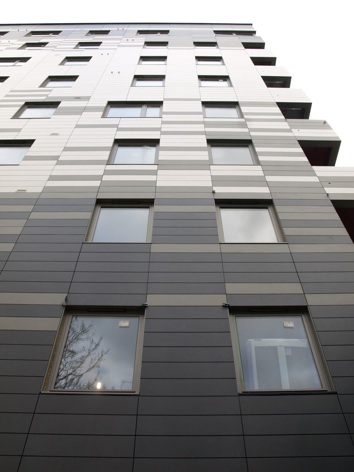Composites are a much talked about topic nowadays, especially in the Advanced Technology and Research practice at Arup with our foray into carbon fibre boat building. But what of the original composite material? Andrew Lawrence, Arup’s leading timber specialist, tells us more.
With the growing interest in man-made composites, it is worth re-evaluating the first composite material - wood. Like man-made composites, wood consists of fibres (cellulose) bonded together in a matrix, in this case of lignin. Used in its strong direction, wood has a strength to weight ratio which is better than mild steel. The fast growing softwoods, such as our familiar ‘Christmas tree’, have about a tenth of the strength of mild steel, but with only a twentieth of the weight – and this explains wood’s popularity for structures where weight matters, such as roofs and aeroplanes.
“Used in its strong direction, wood has a strength to weight ratio which is better than mild steel
Of course the average strength of wood is actually rather more than a tenth of mild steel, but the variability of the material means that for engineering applications it is necessary to use a lower safe design value. The recent history of wood in construction has therefore been an attempt to turn this natural variable material into something with better and more reliable strengths, as well as larger and more stable dimensions. Glulam (literally ‘glued laminated timber’) is well-known and relies on statistical averaging of the knots and other natural defects within the wood when boards are glued together. More recent innovations are LVL (laminated veneer lumber) and CLT (cross-laminated timber). LVL is built up from thin peeled veneers giving a more powerful averaging effect (and therefore higher strengths) than the thicker boards used for glulam. In CLT, as the name suggests, the boards are laminated in two perpendicular directions creating giant plywood-like sheets, with strength and stability in both directions.

Wood is currently undergoing a renaissance in the building industry and it is worth exploring the reasons why to understand whether it has potential in other fields of engineering. First is the ease of forming and machining, enabling increasingly complex forms, epitomised by structures such as the Timber Wave at last year’s London Design Festival made from American red oak. In no other material would it have been possible to form 1000 pieces, each with a different geometry, within the tight budget. Second is the lightweight nature of the material which lends itself to prefabrication and rapid construction. The eight storey Stadthaus in London, in which all the floors and walls are built from solid CLT panels of European spruce, is currently the tallest timber building in the world and demonstrates wood’s ability to compete in a market previously dominated by steel and concrete. Wood’s final benefit is its sustainability credentials, not only as the only renewable construction material (it literally grows on trees!), but also as a material which grows using solar energy and which ultimately at the end of life can be turned into biomass. As the energy price increases so wood is becoming increasingly competitive compared with its more industrially produced competitors. Furthermore, despite the increasing use of softwood in construction, the forests in Northern Europe and America where it is sourced are still increasing in area.

However, there has been a major hurdle to wood’s renaissance and that has been a lack of education. Engineers are much happier working in steel or concrete than in wood, which for many years was seen as old hat. Many engineers make the mistake of joining wood with bolts in a similar way to steel, but of course the fibrous nature of material means it is much better to rely on glue, to avoid splitting behind the bolts. The UK WoodAwards (www.woodawards.com) have been a major force in sharing good practice in the design and detailing of wooden structures. It has been amazing to watch designers find new ways to use the material and to break out of the mould of the two dimensional arched structures that were common in the 70s.
It has been amazing to watch designers find new ways to use the material
And so now it is time for me to throw open the challenge to the other engineering disciplines to explore where wood might have potential to replace some of its more energy and resource intensive competitors. There will be a steep learning curve, but the potential benefits are huge.
Andrew Lawrence is the leading timber specialist at Arup and a judge for the UK WoodAwards.


Poll: Should the UK’s railways be renationalised?
The privatised rail service has always been propped up by public subsidy, so that companies could take their profits, instead of re-investing revenue...